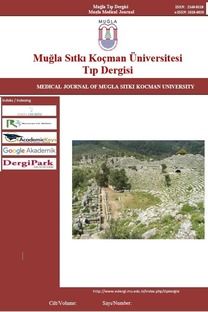Vajinitlerde Etiyoloji Değişiyor mu? Tek Merkez Verilerinin Paylaşımı
Candida, Postmenopoz, Premenopoz, Vajinit
Does the Etiology Change in Vaginitis? Data Results of Samples from a Single Center
Candida, Postmenopause, Premenopause, Vaginitis,
___
- 1. Mccormack WM. Vulvovaginitis and cervicitis. In: Mandell GL, Bennett JE, Dolin R, editors. Mandell, Douglas, and Bennett’s Principles and Practice of Infectious Diseases. 7th ed. Philadelphia, PA: Churchill Livingstone Elsevier; 2010. pp 1495-1509.
- 2. Sobel JD. Vaginitis, vulvitis, cervicitis and cutaneous vulvar lesions. In: Cohen J, Powderly WG, Opal SW editors. Infectious Diseases. 3rd edition. Edinburgh: Elsevier Limited; 2010. pp. 542-50.
- 3. Workowski KA, Bolan GA. Centers for Disease Control and Prevention. Sexually transmitted diseases treatment guidelines, 2015. MMWR Recomm Rep. 2015;64(RR-03):1-137.
- 4. Tempera G, Furneri PM. Management of aerobic vaginitis. Gynecol Obstet Invest. 2010;70(4):244-9.
- 5. Mills BB. Vaginitis: Beyond the basics. Obstet Gynecol Clin North Am. 2017;44(2):159-77.
- 6. Goje O, Munoz JL. Vulvovaginitis: Find the cause to treat it. Cleve Clin J Med. 2017;84(3):215-24.
- 7. Kenyon C, Colebunders R, Crucitti T. The global epidemiology of bacterial vaginosis: a systematic review Am J Obstet Gynecol. 2013;209(6):505-23.
- 8. Baruah FK, Sharma A, Das C, et al. Role of Gardnerella vaginalis as an etiological agent of bacterial vaginosis. Iran J Microbiol. 2014;6(6):409-14.
- 9. Chandeying V, Skov S, Kemapunmanus M, et al. Evaluation of two clinical protocols for the management of women with vaginal discharge in Southern Thailand. Sex Transm Infect. 1998;74(3):194-201.
- 10. Bansal R, Garg P, Garg A. Comparison of Amsel’s criteria and Nugent’s criteria for diagnosis of bacterial vaginosis in tertiary care centre. Int J Reprod Contracept Obstet Gynecol. 2019;8:637-40.
- 11. Chatzivasileiou P, Vyzantiadis TA. Vaginal yeast colonisation: From a potential harmless condition to clinical implications and management approaches—A literature review. Mycoses. 2019;62(8):638-50.
- 12. Kalkancı A, Çiftçi B, Biri A, et al. Vajinit ön tanısı almış olgularda vajinal kültür sonuçlarının değerlendirilmesi. Türkiye Klinikleri J Gynecol Obst. 2005;15:137-9.
- 13. Cengiz A, Cengiz L, Us E. Gebe kadınların vajinal akıntılarından üretilen mikroorganizmaların dağılımı ve antibakteriyellere duyarlılıkları. OMÜ Tıp Derg. 2004;21(2):84-9.
- 14. Esim BE, Kars B, Karsidag AY, et al. Diagnosis of vulvovaginitis: comparison of clinical and microbiological diagnosis. Arch Gynecol Obstet. 2010;282(5):515-9.
- 15. Kaambo E, Africa C, Chambuso R, et al. Vaginal microbiomes associated with aerobic vaginitis and bacterial vaginosis. Front Public Health. 2018;6:78.
- 16. Sangeetha KT, Golia S, Vasudha CL. A study of aerobic bacterial pathogens associated with vaginitis in reproductive age group women (15-45 years) and their sensitivity pattern. Int J Res Med Sci. 2015;3:2268-73.
- 17. Pal K, Sidhu SK, Devi P, et al. Etiology of vaginal infections and antimicrobial resistance pattern of aerobic bacterial isolates in women of reproductive age group attending a tertiary care hospital. Asian Pac J Health Sci. 2017;4(4):15-8.
- 18. Hussain MS, Hussain A, Azam M, et al. Frequency and antimicrobial susceptibility of gram negative rods in high vaginal swabs. JSZMC. 2014;5(2):612-4.
- 19. Raabe VN, Shane AL. Group B Streptococcus (Streptococcus agalactiae). Microbiol Spectr. 2019;7(2).
- 20. Shaw C, Mason M, Scoular A. Group B streptococcus carriage and vulvovaginal symptoms: causal or casual? A case-control study in a GUM clinic population. Sex Transm Infect. 2003;79:246–8.
- 21. Van Gerwen OT, Muzny CA. Recent advances in the epidemiology, diagnosis, and management of Trichomonas vaginalis infection. F1000Res. 2019;8(F1000 Faculty Rev):1666.
- 22. Madhivanan P, Bartman MT, Pasutti L, et al.. Prevalence of Trichomonas vaginalis infection among young reproductive age women in India: implications for treatment and prevention. Sex Health. 2009;6(4):339-44.
- 23. Mulu W, Yimer M, Zenebe Y, et al. Common causes of vaginal infections and antibiotic susceptibility of aerobic bacterial isolates in women of reproductive age attending at Flegehiwot Referral Hospital, Ethiopia: a cross sectional study. BMC Womens Health. 2015;15:42.
- 24. Sönmez C, Usluca S. Ürogenital akıntısı olan olgularda: Trichomonas vaginalis sıklığı? FLORA. 2018;23(2):79-83.
- 25. Akarsu GA. Investigation of Trichomonas vaginalis in patients with nonspecific vaginal discharge. Turkiye Parazitol Derg. 2006;30(1):19-21.
- ISSN: 2148-8118
- Yayın Aralığı: 3
- Başlangıç: 2014
- Yayıncı: Muğla Sıtkı Koçman Üniversitesi
Göksu ALAÇAMLI, Sema TAMER KADERLİ, Aylin KARALEZLİ, Nilay HAKAN
Pençe El Deformitesi ile Birlikte Görülen Chiari Tip 1 Deformitesi: Nadir Bir Olgu Sunumu
Venöz Numune Almada Preanalitik Hataların Tespiti; Acil Servis Deneyimi
Erdem ÇOKLUK, Mehmet Ramazan ŞEKEROĞLU, Fatıma Betül TUNCER, Fatih GÜNEYSU, Selvihan ÇİLLİOĞLU, Meltem BOZ
Vajinitlerde Etiyoloji Değişiyor mu? Tek Merkez Verilerinin Paylaşımı
Muğla Bölgesinde Sakral Dismorfizim Bulgularının Sıklığı
Rabia Mihriban KILINÇ, Cem Yalın KILINÇ, Fatih CAN, Emre GÜLTAÇ, İsmail Gökhan ŞAHİN, Nevres Hürriyet AYDOĞAN
Acil Servisimize Başvuran Hastaların 5 Yıllık Analizi
Ekrem Taha SERT, Hüseyin MUTLU, Kerim YEŞİLDAĞ, Kamil KOKULU, AYHAN SARITAS
Temporal Triangular Alopesili İki Olgu
Onur GÜRSAN, Mustafa ÖZKAN, Ahmet Emrah ACAN
Paraaortik Lenf Nodu Diseksiyonu Sırasında Unilateral Ektopik Böbrek
